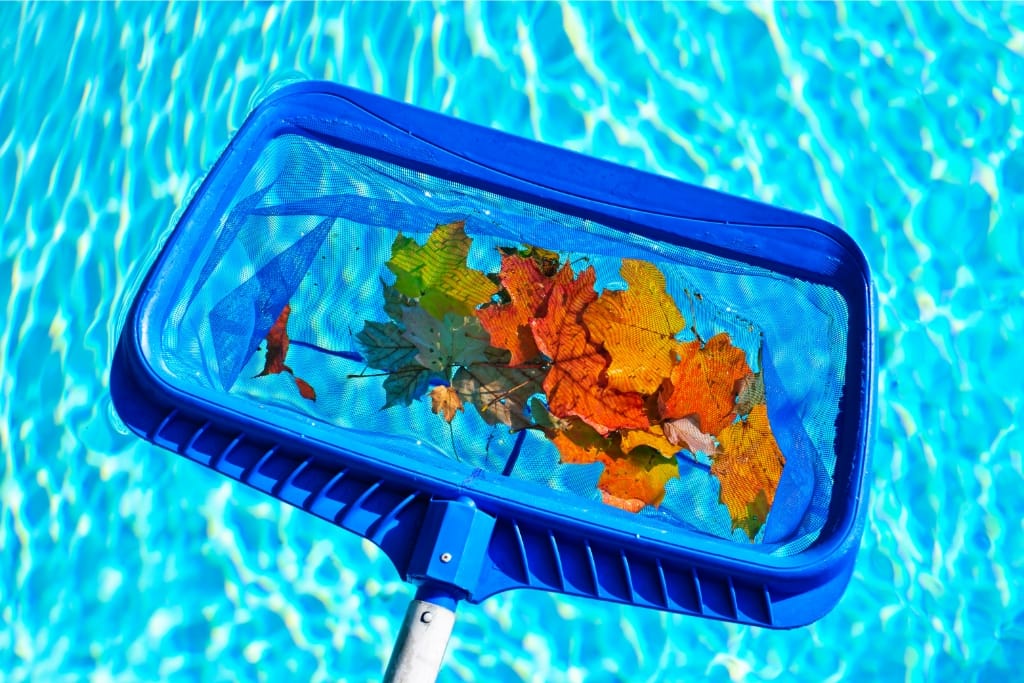Dealing with leaves in your swimming pool can be a frustrating task, but with the right approach, it can be managed effectively and efficiently.
This guide will walk you through a step-by-step process to not only remove leaves from your pool but also to prevent them from becoming a nuisance in the future.
From skimming the surface to vacuuming the pool floor and implementing preventative measures, we've got you covered.
Armed with the right tools and techniques, keeping your pool clean and inviting will be easier than you think.
Whether you're a new pool owner or looking to refine your maintenance routine, these insights will help you maintain a pristine pool environment with minimal effort.
Leaves falling into your swimming pool present a multi-faceted challenge that affects not only the pool’s aesthetics but also its overall health.
They can clog filters, disrupt the water chemistry, and provide breeding grounds for bacteria and algae if not timely addressed.
This seemingly straightforward issue requires regular attention to prevent the leaves from sinking and decomposing, which complicates the cleaning process.
A pool surrounded by trees, while beautiful, demands a strategic approach to leaf management to ensure that the water remains clear, clean, and inviting throughout the seasons.
Maintaining the cleanliness of your swimming pool is crucial for several reasons, ranging from health and safety to the longevity of your pool.
A clean pool prevents the growth of harmful microorganisms and algae, ensuring a safe swimming environment for everyone.
It also helps in keeping the pool's filtration system running smoothly, reducing the need for costly repairs.
Furthermore, a well-maintained pool enhances the aesthetic appeal of your outdoor space, inviting relaxation and enjoyment.
Regular cleaning and maintenance not only secure the health and safety of the swimmers but also preserve the pool’s condition, ensuring it remains a cherished feature of your home for years to come.
Before tackling the challenge of removing leaves from your swimming pool, it’s essential to gather the necessary tools and materials to ensure a smooth and effective cleaning process.
A quality leaf skimmer and a sturdy pool vacuum are indispensable for the physical removal of leaves from the water’s surface and the pool floor, respectively.
Having a set of pool brushes and a telescopic pole will allow for easy reach across the pool and aid in scrubbing away any debris stuck to the sides and bottom.
For preventative measures, investing in a leaf-catching cover can greatly reduce the amount of foliage entering your pool.
Lastly, garden tools for trimming overhanging branches can help minimize the leaf fall from the start.
Having these tools at your disposal will equip you with everything needed to maintain a leaf-free and sparkling clean pool.
Step 1: Skimming The Surface
Skimming the surface of your pool is the first and most immediate step in removing leaves and ensuring your pool remains inviting and clean.
This essential maintenance task prevents leaves from sinking to the bottom and becoming more difficult to remove.
By regularly using a leaf skimmer, you can quickly collect and dispose of floating debris.
This step not only enhances the pool's appearance but also plays a critical role in maintaining water quality and extending the life of your pool's filtration system.
With the right technique and a little diligence, skimming can be an efficient and effective way to keep your pool pristine.
Use A Leaf Skimmer To Remove Floating Leaves
Using a leaf skimmer is a straightforward yet effective method for removing floating leaves from your swimming pool.
This simple tool, typically attached to a telescopic pole, allows you to easily reach across the pool and skim the surface, capturing leaves and other floating debris.
For best results, move the skimmer gently across the water in a steady, sweeping motion, which helps to gather the leaves efficiently without pushing them away.
Regularly clearing the skimmer's net ensures that you can continue collecting leaves without hindrance.
This task, although seemingly mundane, is vital in maintaining the aesthetic appeal of your pool and preventing potential filtration issues caused by accumulated debris.
Techniques For Efficient Skimming
To enhance the efficiency of skimming leaves from your pool, several techniques can optimize the process.
Firstly, skimming in a patterned approach, such as starting from one end of the pool to the other or working in a spiral from the outside towards the center, ensures no areas are missed and debris is not unnecessarily disturbed.
Secondly, timing plays a crucial role; skimming during the calmest parts of the day, usually early morning or late evening, when the wind is minimal, can prevent the debris from dispersing across the pool surface.
Adjusting the angle of the skimmer to match the water's surface tension can significantly increase the collection of leaves.
Combining these strategies with regular skimming sessions will greatly reduce the workload and maintain the pool’s cleanliness and functionality.
Disposing Of Collected Leaves Properly
Disposing of collected leaves properly is an essential follow-up to the skimming process.
Simply removing leaves from your pool is not the end of the task; how you handle the waste can impact both your garden's health and local ecosystems.
Composting the leaves serves as an excellent option, turning this organic matter into nutrient-rich soil that can benefit your garden beds.
Alternatively, many localities offer yard waste collection services, allowing for the eco-friendly disposal of garden debris.
Ensure that leaves are bagged according to local regulations to avoid fines.
Proper disposal not only keeps your pool area tidy but also contributes to a sustainable cycle of organic waste management.
Step 2: Vacuuming The Pool
After the surface has been thoroughly skimmed and all floating leaves are removed, the next critical step in maintaining a clean and inviting pool is vacuuming.
Vacuuming the pool effectively removes debris that has settled at the bottom, ensuring the water remains clear and preventing the accumulation of sediments that could lead to algae growth.
This step is essential for maintaining the aesthetic quality of your pool and safeguarding the health of its water, making it a pivotal aspect of routine pool maintenance.
With the right equipment and technique, vacuuming can be a straightforward task that significantly contributes to the overall well-being of your swimming pool.
Preparing Your Pool Vacuum
Preparing your pool vacuum correctly is a fundamental step to ensure the efficiency of the cleaning process.
Start by assembling the vacuum head, hose, and telescopic pole according to the manufacturer's instructions.
Once assembled, slowly submerge the vacuum head into the pool, ensuring that it remains fully submerged to avoid air pockets within the hose, which can decrease suction power.
Next, connect the other end of the hose to the pool's skimmer or vacuum port, depending on your pool’s setup.
It’s important to ensure that all connections are secure to maintain optimal suction.
Properly preparing your pool vacuum not only facilitates a smoother cleaning process but also helps extend the life of your pool equipment.
Vacuuming The Pool Floor And Walls
Vacuuming the pool floor and walls is a meticulous process that requires attention to detail to ensure thorough cleaning.
Gently guide the vacuum head over the pool's floor, walls, and corners, moving in a slow and steady pattern to avoid stirring up debris, which can cloud the water and reduce visibility.
Focus on areas with noticeable accumulation of dirt and leaves, as these are prone to developing algae if left unattended.
Regular vacuuming prevents the buildup of sediment, contributing to a healthier swimming environment and ensuring the pool's surfaces are visually appealing and safe for swimmers.
This task, although time-consuming, is crucial for the long-term maintenance and enjoyment of your pool.
Care And Maintenance Of Your Pool Vacuum
Proper care and maintenance of your pool vacuum are essential to ensuring its longevity and effectiveness in cleaning your pool.
After each use, it is vital to rinse the vacuum head, hose, and any attachments with fresh water to remove chlorine, debris, and any chemical residue that could degrade the materials over time.
Inspect the vacuum head for signs of wear or damage, especially on the brushes or wheels, and replace them as necessary to maintain efficient cleaning performance.
Store the vacuum and its components in a cool, dry place, out of direct sunlight to prevent cracking and fading caused by UV exposure.
Following these simple yet effective maintenance steps will keep your pool vacuum in optimal condition, ready for its next use.
Pro-Tip: For pool owners who prefer a hands-off approach to cleaning leaves and debris, investing in a Robotic Pool Cleaner can be a game-changer.
These autonomous cleaners operate independently of the pool's filtration system, equipped with sophisticated technology to map out and efficiently clean the pool's floor, walls, and in some models, even the waterline.
With features designed to tackle various types of debris, including fine particles and large leaves, a robotic cleaner can save significant time and effort, allowing you to enjoy a pristine pool without manual labor.
Their energy-efficient operation also means lower operating costs, making them an eco-friendly and convenient solution for keeping your pool clean and swim-ready at all times.
Step 3: Preventing Future Leaf Problems
Preventing future leaf problems is a proactive approach to pool maintenance that can save time and effort in the long run.
This step involves strategies and modifications to minimize the amount of leaves and debris that find their way into your pool.
Whether it's through the use of pool covers, strategic landscaping, or installing leaf-catching systems, several effective measures can be implemented.
By addressing the issue at its source, pool owners can significantly reduce the frequency and intensity of cleaning sessions, ensuring their pool remains a clear and inviting oasis with less effort.
Installing Leaf-Catching Covers
Installing leaf-catching covers is an efficient and effective method for keeping leaves and debris out of your pool.
These covers are designed to be placed over the pool’s surface when it is not in use, acting as a barrier against falling leaves and twigs.
Not only do they help prevent the accumulation of debris in the water, but they also make pool maintenance easier and less frequent.
There are various types of leaf-catching covers available, including mesh covers that allow water to permeate while trapping larger debris and solid covers with debris screens.
Selecting the right type depends on your specific needs and the amount of foliage surrounding your pool area.
Integrating a leaf-catching cover into your pool maintenance routine can significantly mitigate future leaf problems, keeping your pool clean and ready for use with minimal additional effort.
Regular Trimming Of Surrounding Trees And Bushes
Regular trimming of surrounding trees and bushes plays a critical role in preventing leaf problems in your pool.
Overhanging branches and lush vegetation around the pool area are major contributors to the accumulation of debris in the water.
By periodically cutting back branches and trimming bushes, you can significantly reduce the amount of leaves and twigs that fall into the pool, thereby easing the burden of pool maintenance.
This preventive measure not only keeps the pool cleaner but also helps in maintaining a tidy and aesthetically pleasing outdoor area.
Furthermore, trimming vegetation can also reduce the risk of potential damage to pool surfaces and filtering systems from branches and natural debris, ensuring the longevity and functionality of pool equipment.
Pro-Tip: Investing in high-quality power hedge trimmers, manual hedge clippers, and shears for maintaining areas around a pool is a savvy long-term decision for any pool owner.
Power hedge trimmers allow for quick and efficient trimming of larger areas and thick branches, significantly reducing the time and effort involved in maintenance.
Manual hedge clippers and shears, on the other hand, offer precision for shaping and controlling the growth of bushes and small trees, ensuring that your pool area is not only leaf-free but also visually appealing.
High-quality tools are more durable, perform better, and provide a cleaner cut, which is healthier for your plants.
This combination of tools will prove indispensable in your pool maintenance kit, ensuring a pristine pool environment with minimal debris and an attractive landscape.
Strategic Landscaping To Minimize Leaf Fall Into The Pool
Strategic landscaping to minimize leaf fall into the pool is an innovative and natural approach to reducing pool maintenance needs.
By choosing plants and trees that are less prone to shedding, or positioning foliage in areas where the wind is less likely to blow leaves into the pool, homeowners can significantly cut down on the time spent removing debris from their pools.
The use of hardscaping elements such as stone walls or pathways can act as barriers to leaves while enhancing the aesthetic appeal of the outdoor space.
Thoughtful planning and design of the landscape not only contribute to a more manageable pool upkeep routine but also promote a harmonious and attractive outdoor living environment.
Conclusion
In this document, we meticulously outlined a series of steps aimed at ensuring the cleanliness of your pool and reducing maintenance efforts related to leaf and debris accumulation.
Starting with the crucial task of regular vacuuming to keep the pool's environment healthy and visually appealing, we moved on to emphasize the importance of the care and maintenance of your pool vacuum equipment for its longevity and effectiveness.
Preventing future leaf problems received attention through techniques such as installing leaf-catching covers, regular trimming of surrounding trees and bushes, and strategic landscaping to minimize leaf fall into the pool.
Each step provided practical and effective strategies designed to enhance your pool's cleanliness and reduce the need for frequent maintenance, ensuring a more enjoyable and stress-free pool ownership experience.
Beyond the strategies detailed, additional tips for keeping your pool leaf-free include installing a pool skimmer basket liner or sock, which acts as an extra barrier to catch smaller debris that might escape standard filtration systems.
Frequent skimming of the pool's surface, either manually or with an automated device, can greatly reduce the workload on the pool's filtration system, ensuring it runs more efficiently and prolongs its lifespan.
Also, considering a windbreak such as a fence or hedge can significantly reduce the amount of windborne debris entering the pool area.
Implementing these supplementary measures, alongside the main strategies outlined, will further minimize leaf and debris problems, maintaining your pool’s pristine condition with less effort.
Maintaining a regular cleaning schedule for your pool is instrumental in preserving its health and vitality, ensuring that it remains a source of joy and relaxation for you and your loved ones.
A consistent routine not only helps in preventing the buildup of leaves and debris but also assists in monitoring the pool's chemical balance and detecting any potential issues early on, avoiding the need for more complex and costly remedies down the line.
Committing to a set schedule can significantly diminish the overall maintenance effort required, by keeping problems manageable and ensuring that your pool remains in inviting condition all season long.
Remember, the key to minimizing pool maintenance woes lies in the proactive and regular care of your swimming oasis.
Are You Looking For The Best Pool Builders In Sacramento CA? Click Here To Get In Touch With A Pool Building Expert Today!
Download Our Free E-book!








